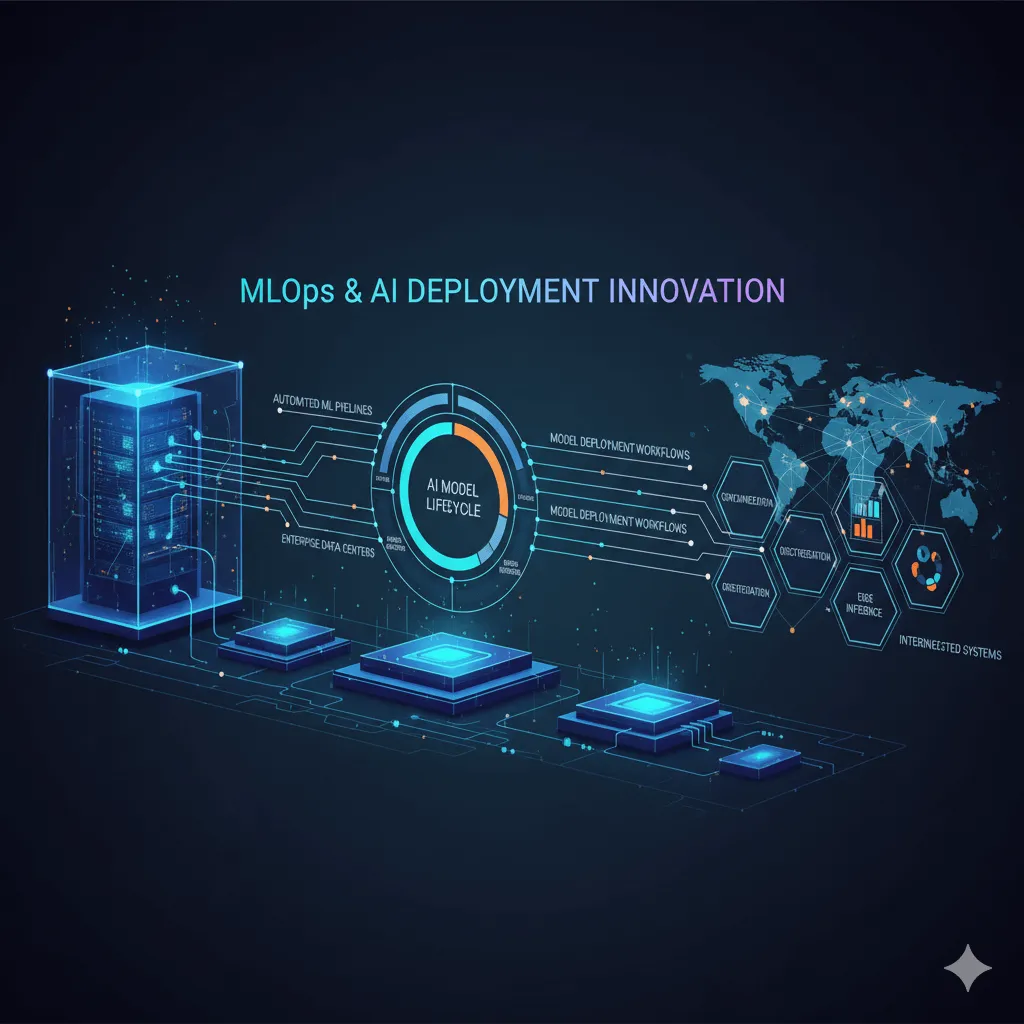MLOps Breakthrough: Transforming Enterprise AI


The Silent Revolution Transforming Enterprise AI
While the tech press obsesses over ever-larger language models and billion-dollar training runs, a quieter but arguably more important revolution is transforming how enterprises actually deploy and operate AI systems. This breakthrough isn’t about making models bigger or smarter—it’s about making them dramatically easier, faster, and cheaper to deploy in real business environments.
Recent developments in MLOps (Machine Learning Operations) are solving the fundamental challenge that has plagued enterprise AI adoption: the gap between building impressive models in research labs and successfully deploying them in production environments where they deliver real business value.
This isn’t just theoretical. Companies implementing these new MLOps approaches are seeing deployment times drop from months to weeks, operational costs decrease by 50-80%, and model performance improve through better monitoring and continuous optimization. The 2025 AI Breakthrough Award for MLOps Innovation recognized solutions that are making these dramatic improvements possible.
The Enterprise AI Deployment Crisis
For years, enterprise AI initiatives have suffered from a fundamental disconnect. Data science teams could build sophisticated models in controlled environments, but getting those models into production—where they could actually impact business outcomes—remained a herculean task.
Traditional AI deployment workflows were characterized by:
Manual Handoffs: Data scientists would “throw models over the wall” to IT operations teams, who often lacked the specialized knowledge to properly deploy machine learning systems. This led to weeks or months of back-and-forth to resolve configuration issues, dependency conflicts, and performance problems.
Infrastructure Complexity: Enterprise environments typically involve complex security requirements, compliance constraints, and integration needs with existing systems. Traditional deployment approaches required extensive custom engineering for each use case, making AI projects expensive and time-consuming.
Monitoring Gaps: Once deployed, many AI systems operated as “black boxes” with minimal visibility into performance degradation, data drift, or model bias. This made it difficult to maintain model accuracy over time or identify when models needed retraining.
Scalability Challenges: As organizations tried to deploy multiple AI models across different business units, they encountered bottlenecks in infrastructure management, resource allocation, and model version control.
The New MLOps Paradigm: Integrated Automation
The breakthrough in MLOps centers on integrated automation platforms that unify the entire AI lifecycle—from data preparation through model training, deployment, monitoring, and continuous improvement. These platforms address the core enterprise deployment challenges through several key innovations:
Unified Development Environments: Modern MLOps platforms provide integrated toolchains that allow data scientists to develop, test, and deploy models within a single environment. This eliminates the traditional handoff friction and ensures that models are production-ready from the start.
Infrastructure Abstraction: Rather than requiring specialized engineering for each deployment, new MLOps solutions abstract away infrastructure complexity through containerization, orchestration, and cloud-agnostic deployment capabilities. This allows organizations to deploy AI models consistently across different environments while maintaining security and compliance.
Automated Model Lifecycle Management: Advanced MLOps platforms automate the entire model lifecycle, including version control, testing, deployment, monitoring, and rollback capabilities. This reduces the operational burden on IT teams while ensuring consistent model performance.
Real-Time Monitoring and Optimization: Modern solutions provide comprehensive monitoring dashboards that track model performance, data quality, and business outcomes. When issues are detected, these systems can automatically trigger retraining, adjust model parameters, or alert teams to potential problems.
Real-World Impact: Transforming Enterprise Operations
The impact of these MLOps innovations extends far beyond technical efficiency gains. Organizations implementing modern MLOps approaches are seeing transformative business results:
Financial Services: Banks deploying automated MLOps pipelines for fraud detection are reducing false positives by 40% while cutting deployment times from 6 months to 3 weeks. This translates to millions in reduced operational costs and improved customer experience.
Healthcare: Hospital systems using integrated MLOps platforms for diagnostic AI are achieving 99.9% uptime for critical models while reducing the time to deploy new diagnostic capabilities from quarters to weeks.
Manufacturing: Industrial companies implementing continuous model monitoring are detecting equipment failures 3x earlier than traditional approaches, reducing unplanned downtime and maintenance costs.
Retail: E-commerce platforms leveraging automated A/B testing and model versioning are optimizing recommendation engines 5x faster than manual approaches, driving significant increases in conversion rates.
The Technology Stack: Enabling Enterprise-Scale AI
Modern MLOps solutions typically combine several key technology components:
Container Orchestration: Kubernetes-based platforms that manage model deployment, scaling, and resource allocation across hybrid and multi-cloud environments.
Feature Stores: Centralized repositories that manage the data features used by AI models, ensuring consistency between training and production environments while enabling feature reuse across different models.
Model Registries: Version-controlled repositories that track model artifacts, metadata, and performance metrics throughout the model lifecycle.
Automated Pipelines: Workflow orchestration systems that automate data preparation, model training, validation, and deployment processes.
Monitoring and Observability: Real-time dashboards and alerting systems that track model performance, data quality, and business outcomes.
Implementation Strategy: Getting MLOps Right
Successfully implementing modern MLOps approaches requires a strategic approach that addresses both technical and organizational challenges:
Start with Business Outcomes: Rather than beginning with technology selection, organizations should identify specific business problems where faster AI deployment would create measurable value. This ensures that MLOps investments are aligned with business priorities.
Build Cross-Functional Teams: Effective MLOps requires collaboration between data scientists, IT operations, security teams, and business stakeholders. Organizations should create dedicated MLOps teams that bridge these different functions.
Invest in Platform Engineering: Rather than expecting data scientists to become infrastructure experts, organizations should invest in platform engineering capabilities that provide self-service MLOps tools and automated workflows.
Plan for Continuous Improvement: MLOps isn’t a one-time implementation project—it’s an ongoing capability that requires continuous investment in tools, processes, and skills development.
The Competitive Advantage: Speed and Agility
Organizations that master modern MLOps approaches gain significant competitive advantages:
Faster Time-to-Value: Companies deploying AI models in weeks rather than months can respond more quickly to market opportunities and competitive threats.
Reduced Operational Risk: Automated monitoring and management capabilities reduce the likelihood of model failures and performance degradation.
Improved Innovation Cycles: Streamlined deployment processes enable more experimentation and faster iteration on AI applications.
Cost Optimization: Efficient resource utilization and reduced operational overhead lower the total cost of AI initiatives.
The Road Ahead: MLOps Evolution
The MLOps breakthrough represents more than just incremental improvement—it’s a fundamental shift in how enterprises approach AI deployment and operations. As these technologies mature, we can expect to see:
Increased Automation: Future MLOps platforms will automate even more aspects of the AI lifecycle, potentially reducing human involvement in routine deployment and maintenance tasks.
Enhanced Governance: As regulatory requirements for AI systems become more stringent, MLOps platforms will incorporate automated compliance checking and audit trail generation.
Edge Deployment: As AI moves beyond data centers to edge devices, MLOps platforms will need to support deployment and management across distributed computing environments.
Cross-Platform Integration: MLOps solutions will increasingly integrate with broader enterprise IT ecosystems, including data lakes, business intelligence platforms, and application development tools.
Conclusion: The New AI Imperative
The MLOps breakthrough fundamentally changes the economics of enterprise AI adoption. Organizations that embrace these innovations will find themselves with significant advantages in speed, efficiency, and operational excellence. Meanwhile, those that continue relying on traditional, manual approaches to AI deployment may find themselves unable to keep pace with more agile competitors.
The question isn’t whether MLOps will transform enterprise AI—it’s whether your organization will be leading that transformation or struggling to catch up. The time to invest in modern MLOps capabilities is now, while the competitive advantages are still substantial and the implementation challenges are still manageable.
The future of enterprise AI belongs to organizations that can deploy, operate, and continuously optimize AI systems as efficiently as they manage traditional enterprise applications. Modern MLOps platforms are making that future a reality today.
Frequently Asked Questions
What exactly is MLOps and why does it matter for enterprise AI?
MLOps (Machine Learning Operations) refers to the practices, tools, and processes that enable organizations to deploy, monitor, and maintain machine learning models in production environments. It matters for enterprise AI because traditional approaches to AI deployment often result in months-long delays between model development and production deployment, leading to missed business opportunities and wasted investment. MLOps bridges the gap between data science research and production operations, enabling faster time-to-value for AI initiatives.
How do modern MLOps platforms differ from traditional model deployment approaches?
Modern MLOps platforms provide integrated automation that unifies the entire AI lifecycle, from data preparation through model deployment, monitoring, and continuous optimization. Traditional approaches involved manual handoffs between data science and IT operations teams, leading to weeks or months of back-and-forth to resolve configuration issues. Modern platforms automate infrastructure provisioning, model versioning, testing, and deployment, reducing deployment times from months to weeks while improving reliability and performance.
What are the key business benefits of implementing MLOps solutions?
Organizations implementing modern MLOps approaches typically see: 50-80% reduction in operational costs, deployment times reduced from months to weeks, improved model performance through better monitoring and continuous optimization, faster innovation cycles enabling more experimentation, and reduced operational risk through automated testing and rollback capabilities. Specific industry benefits include reduced fraud detection false positives in financial services, earlier equipment failure detection in manufacturing, and improved recommendation accuracy in retail.
What technical components make up a modern MLOps platform?
Modern MLOps platforms typically combine: container orchestration systems (like Kubernetes) for managing model deployment and scaling, feature stores for managing data features consistently between training and production, model registries for version control and metadata management, automated pipeline orchestration for streamlining workflows, and comprehensive monitoring and observability tools for tracking model performance and business outcomes in real-time.
How should organizations approach MLOps implementation?
Successful MLOps implementation requires a strategic approach: start with specific business outcomes where faster AI deployment creates measurable value, build cross-functional teams that bridge data science, IT operations, and business stakeholders, invest in platform engineering capabilities that provide self-service tools and automated workflows, and plan for continuous improvement as MLOps is an ongoing capability rather than a one-time project. Organizations should avoid trying to implement everything at once and instead focus on iterative improvements that deliver measurable business value.